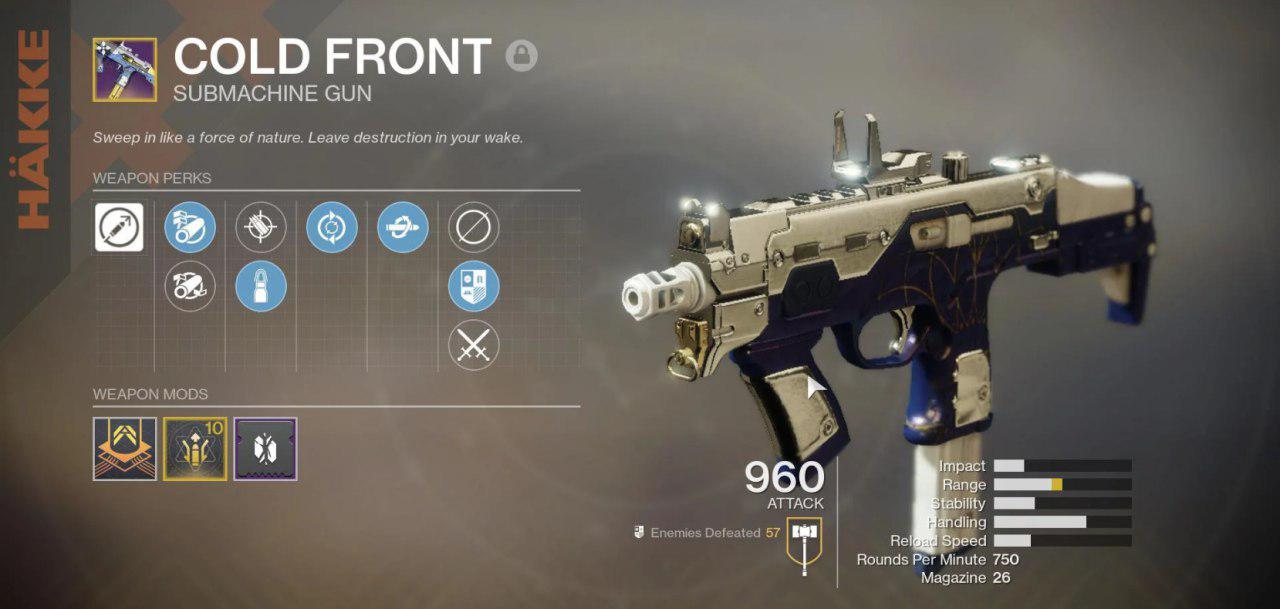The Cold Front SMG is one of two exclusive weapon rewards for the 2019 Dawning event. The other is the previous year’s Solar Machine Gun, Avalanche.
TLDR; Cold Front destroys in PVP… if you can land all critical hits against aggressive shotgun pushers.
You can get this weapon by farming ingredients to bake cookies in your oven, turning those cookies in to their respective vendors, some of whom will return the favor by giving you a wrapped Gift Box. You then open this gift, which can randomly reward you Dawning weapons or materials.
The Moultrie operates with a digital timer that can be programmed to feed six times a day, with each feed lasting between one to twenty seconds depending on how you configure the system. A one 6-volt battery is required in order to power this timer. The timer has a three-hundred-and-sixty-degree feed pattern for the most widespread coverage.
Cold Front is one of two Legendary, Aggressive Sub-Machine Guns introduced into Destiny 2 since Forsaken’s launch back in September 2018. The other is Hard Truths, which you earn by completing Crucible matches and turning in tokens to Shaxx in the tower.
For me personally, Blast Furnace with Meyrin RDS, Tac Mag, Feeding Frenzy and Kill Clip is the best one. With a range MW its got 96 range, and still enough stability to hit all crits at the very edge of that range. I lurve it to death. Great for those times when you are popping off left and right, jumping around like a sweaty tryhard on adderall. As far as sidearms go, this gun is definitely at the top of my list. After a couple of attempts, got a roll with Farpoint SAS, Armor Piercing/Ricochet Rounds, Feeding Frenzy, Multi-kill Clip, and ranged MW. So far, this has been my replacement to Recluse, and it does not disappoint. This thing is a wood chipper once it gets a couple kills in.
This weapon is a Kinetic primary, firing 750 rounds-per-minute. This particular archetype of SMG has a .67 time-to-kill in the Crucible without any perks to weapon damage. If that sounds too fast for a non-buffed primary, it’s because the weapon’s range is severely limited compared to both Precision and Adaptive Frame SMGs.
Range is this weapon’s greatest weakness. With damage drop off starting as close as 17 meters, you’ll be at a severe disadvantage against Hand Cannons, Pulse Rifles, and other SMG frames.
Given its lightning fast TTK and limited range, Cold Front is best used as a defensive counter to overconfident shotgun rushers and Shoulder-Charging Titans. Find an angle and use your radar and other information sources to predict your enemies’ pushes.
Being aggressive with this weapon will see your KD/A plummet in most matches. A well rolled Mind Bender’s Ambition or any other Aggressive Frame shotgun (a popular choice in today’s sandbox) will kill you from as far as 9 to 10 meters out. If you do rush and survive the first shot, the follow up shot or melee attack after it will easily send you to your next respawn point.
My suggested perks:
Barrel Perks: Smallbore (PC, Console). The Aggressive Frame SMGs are known for a lack of Range and Stability. This helps both.
Ammo and Magazines: Accurized Rounds (PC), Steady Rounds (Console). Range remains a priority for mouse and keyboard, while Stability is generally the best option for players on Console.
Third Column: Feeding Frenzy (PC, Console) in first place, with Zen Moment a close second. Feeding Frenzy’s reload speed equals that of Outlaw without requiring a precision kill. Zen Moment is a nice bump to Stability and should be welcomed if your Cold Front rolls with it.
Fourth Column: Killclip (PC, Console). Killclip brings this weapon’s optimal TTK down to .5 seconds, which is kind of crazy. Great for both PVP and PVP. Vorpal Weapon can be fun for surprising unsuspecting Guardians in their Super.
Recommended Mods: Counterbalance, Icarus Grip, Back-up Mag.
Recommended Masterworks: Range (PC), Stability (Console).
Evidence suggests that European monks introduced carp into the UK around the turn of the 17th century. Since then, anglers have been studying the carp and its environment as a means of locating and catching the fish. In the 1990s, much work was done to determine the impact of the moon, wind direction, air pressure changes, oxygen content and water temperature on carp behaviour.
Try to go carp fishing in the appropriate weather conditions or you may end up catching the catfish instead! This beast wrestled Mac into submission. It weighed over 85 pounds - my lucky father!
The Moon
Questions have arisen as to whether the moon phases affect carp fishing. Many saltwater fishermen use solunar tables to calculate prime fishing times. The tables are based on a combination of moon phases and sun/moon rise/set times and rate the various time periods each day. There is some computer software available that can do solunar calculations, but these are usually only suited to North America. It is uncertain how moon phases would affect freshwater fishing as there is no tidal factor to consider.

Wind Direction
The direction of the wind has a direct impact on the feeding habits of carp. Anglers know that nutrients in the water change direction to match that of the surface winds. Carp follow the nutrients because they can taste and smell items in the water. They have a highly sensitive olfactory system that allows them to sense any dissolved substance in the water and determine whether or not it is a good food source. In addition, the lining of the carp’s mouth contains chemically sensitive cells that allow it to determine whether that food is good or bad. As the wind driven water hits a shoreline, the under-current stirs up food from the bottom, attracting the fish. When the food becomes scarce, the carp will move further from the bank and gradually disperse across the lake to new areas. A change in the wind to a new direction will encourage the fish to move into the windward shore again.
It has also been suggested that the wind blows on the fisherman’s line and sends the vibrations down it and that attracts the fish to the bait. When the fish picks up the bait, it feels the vibrations and runs with the line. When the wind stops blowing, the bite doesn't stop but the runs do. When the wind picks back up the runs soon follow.
Air Pressure Changes
Research has been done into whether barometric pressure has any effect on carp. When the barometer drops, carp tend to stop moving and start feeding on dead materials. When it rises, carp become more active and feed on living things.

Weather
Today, most anglers know that weather affects the quality of fishing. Poor weather conditions, such as clouds and rain, increase the probability of catching a carp. Rain in warm weather cools the water and increases oxygen levels. This freshens up the water and makes the carp more sensitive to the smell of the bait. Cold weather appears to have the reverse effect. Carp become less excited and more difficult to catch. In clear water under sunny conditions, the carp’s ability to see is excellent, depending on its depth in the water. Cloudy conditions, on the other hand, reduce the amount of light in the water and have the side effect of hiding the angler’s presence.
Oxygen Content
Carp can survive in low oxygen water (0.3-0.5 mg/litre), stagnant pools or waterways or in rivers heavily contaminated by human sewage, industrial and agricultural toxins and wastes. Carp are capable of absorbing large amounts of Mercury, PCB and heavy metals in their tissue. Because of this, they should not be eaten if they are taken from contaminated waters. Carp can also thrive in oxygen rich waters.
Water Temperatures
Changes in water temperature alter the feeding habits of carp. Increases in temperature can significantly reduce the number of fish caught. Where the weather is warmer for longer periods, the feeding patterns gradually return to normal. In such areas, a change of bait is helpful. Boilies made with less casein and more carbohydrate, such as semolina, seem more effective. Smaller and/or softer baits have also been found to get better response.
It was once thought that carp could not be caught in water above 21c or in water below 16c. Research indicates that they can survive inside a block of ice with only a small amount of free water in the centre. They can do this because of their ability to modify their muscle properties and swimming performance following several weeks of temperature adaptation. In the cold winter months, carp generally stay near the bottom. A good rule of thumb for winter is to fish at the peak temperature times when the water warms slightly. Carps’ feeding periods will be shorter and less intense than in warmer months. The angler should realize that the fish are far more selective in where and on what they'll feed during the winter.
Spawning
Changes in water temperature have an affect on carp’s spawning habits. Carp spawn in the spring and early summer when the water temperature is around 16-26C. It may take place over several days. The embryonic development of carp takes about 3 days at 20-23C. If hatching comes too close to winter the young carp fry do not have enough time to build up reserves of fat before winter sets in and they perish. Growth is rapid where the water is warm and rich in food. Carp can reach 0.9kg and 15cm in length in a year. They continue to grow at that rate, but not in waters that are too cold (below 10C) to encourage maximum size. The ideal temperature for maximum growth is 20-28C.
References for the above Carp Article:
Al-Hamed, MI. Carp Culture in the Republic Of Iraq. Found in Proceedings of the FAO World Symposium on Warm Water Pond Fish Culture.
URL: http://www.fao.org/docrep/005/61036T/61036T10.htm. [Accessed Feb 23 2007].
Dawson, Peter. 1996. Carp-l FAQ. URL: Weather.
URL: http://www.carp.net/faq/cfaq_6.htm. [Accessed Feb 23 2007].
Grattidge, Julian. Oct 24, 2005. Beginners Guide to Carp Fishing – Part 2: Watercraft. URL:
http://www.northwestcarp.co.uk/Carp-Articles/Beginners-Carp-Guide/Guide_Carp_Fishing2_Watercraft.html.
[Accessed Feb 23 2007].
Hayes, Matt. No date given. Ask Matt Hayes,
Feeding Frenzy Kill Clip Cold Front Teeth
URL: http://www.anglersnet.co.uk/authors/matt13.htm [Accessed Feb 23 2007].
Herkel. 2007. Wind and Carp? Carp Anglers Group. URL:
http://www.carpanglersgroup.com/forum/index.php?showtopic=19926&pid=275480&st=15&#entry275480.
[Accessed Feb 23 2007].
Peteri, A. January 31, 2007. Cultured Aquatic Species Information Programme - Cyprinus carpio. FAO Inland Water Resources and Aquaculture Service (FIRI). c2004- .
URL: http://www.fao.org/figis/servlet/static?dom=culturespecies&xml=Cyprinus_carpio.xml
[Accessed Feb 23 2007].
Related Carping Links:
Comments are closed.